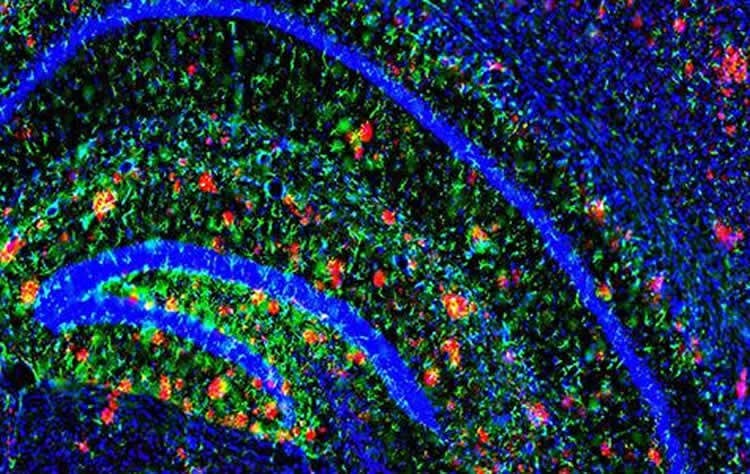The greatest risk factor for Alzheimer’s disease is advancing age. After 65, the risk doubles every five years, and 40 percent or more of people 85 and older are estimated to be living with the devastating condition.
Researchers at Washington University School of Medicine in St. Louis have identified some of the key changes in the aging brain that lead to the increased risk. The changes center on amyloid beta 42, a main ingredient of Alzheimer’s brain plaques. The protein, a natural byproduct of brain activity, normally is cleared from the brain before it can clump together into plaques. Scientists long have suspected it is a primary driver of the disease.
“We found that people in their 30s typically take about four hours to clear half the amyloid beta 42 from the brain,” said senior author Randall J. Bateman, MD, the Charles F. and Joanne Knight Distinguished Professor of Neurology. “In this new study, we show that at over 80 years old, it takes more than 10 hours.”
The slowdown in clearance results in rising levels of amyloid beta 42 in the brain. Higher levels of the protein increase the chances that it will clump together to form Alzheimer’s plaques.
The results appear online in the Annals of Neurology.
For the study, the researchers tested 100 volunteers ages 60 to 87. Half had clinical signs of Alzheimer’s disease, such as memory problems. Plaques had begun to form in the brains of 62 participants.
The subjects were given detailed mental and physical evaluations, including brain scans to check for the presence of plaques. The researchers also studied participants’ cerebrospinal fluids using a technology developed by Bateman and co-author David Holtzman, MD, the Andrew B. and Gretchen P. Jones Professor and head of the Department of Neurology at Washington University. The technology — known as stable isotope-linked kinetics (SILK) — allowed the researchers to monitor the body’s production and clearance of amyloid beta 42 and other proteins.
In patients with evidence of plaques, the researchers observed that amyloid beta 42 appears to be more likely to drop out of the fluid that bathes the brain and clump together into plaques. Reduced clearance rates of amyloid beta 42, such as those seen in older participants, were associated with clinical symptoms of Alzheimer’s disease, such as memory loss, dementia and personality changes.

Scientists believe the brain disposes of amyloid beta in four ways: by moving it into the spine, pushing it across the blood-brain barrier, breaking it down or absorbing it with other proteins, or depositing it into plaques.
“Through additional studies like this, we’re hoping to identify which of the first three channels for amyloid beta disposal are slowing down as the brain ages,” Bateman said. “That may help us in our efforts to develop new treatments.”
Funding: This research was supported by the National Institutes of Health (NIH), grants R01NS065667, K23AG030946, P50 AG05681, P01 AG03991, UL1 RR024992, P30 DK056341, P41 GM103422 and P30 DK020579; the Adler Foundation; and by philanthropic gifts from Edwin and Barbara Shifrin and Jeff Roschman.
Source: Michael C. Purdy – WUSTL
Image Credit: The image is credited to John Cirrilto
Original Research: Abstract for “Age and amyloid effects on human central nervous system amyloid-beta kinetics” by Bruce W. Patterson, Donald L. Elbert, Kwasi G. Mawuenyega, Tom Kasten, Vitaliy Ovod, Shengmei Ma, Chengjie Xiong, Robert Chott, Kevin Yarasheski, Wendy Sigurdson, Lily Zhang, Alison Goate, Tammie Benzinger, John C. Morris, David Holtzman and Randall J. Bateman in Annals of Neurology. Published online July 20 2015 doi:10.1002/ana.24454
Abstract
Age and amyloid effects on human central nervous system amyloid-beta kinetics
Objective
Age is the single greatest risk factor for Alzheimer’s disease (AD), with the incidence doubling every 5 years after age 65. However, our understanding of the mechanistic relationship between increasing age and the risk for AD is currently limited. We therefore sought to determine the relationship between age, amyloidosis, and amyloid-beta (Aβ) kinetics in the central nervous system (CNS) of humans.
Methods
Aβ kinetics were analyzed in 112 participants and compared to the ages of participants and the amount of amyloid deposition.
Results
We found a highly significant correlation between increasing age and slowed Aβ turnover rates (2.5-fold longer half-life over five decades of age). In addition, we found independent effects on Aβ42 kinetics specifically in participants with amyloid deposition. Amyloidosis was associated with a higher (>50%) irreversible loss of soluble Aβ42 and a 10-fold higher Aβ42 reversible exchange rate.
Interpretation
These findings reveal a mechanistic link between human aging and the risk of amyloidosis, which may be owing to a dramatic slowing of Aβ turnover, increasing the likelihood of protein misfolding that leads to deposition. Alterations in Aβ kinetics associated with aging and amyloidosis suggest opportunities for diagnostic and therapeutic strategies. More generally, this study provides an example of how changes in protein turnover kinetics can be used to detect physiological and pathophysiological changes and may be applicable to other proteinopathies.
“Age and amyloid effects on human central nervous system amyloid-beta kinetics” by Bruce W. Patterson, Donald L. Elbert, Kwasi G. Mawuenyega, Tom Kasten, Vitaliy Ovod, Shengmei Ma, Chengjie Xiong, Robert Chott, Kevin Yarasheski, Wendy Sigurdson, Lily Zhang, Alison Goate, Tammie Benzinger, John C. Morris, David Holtzman and Randall J. Bateman in Annals of Neurology. Published online July 20 2015 doi:10.1002/ana.24454







